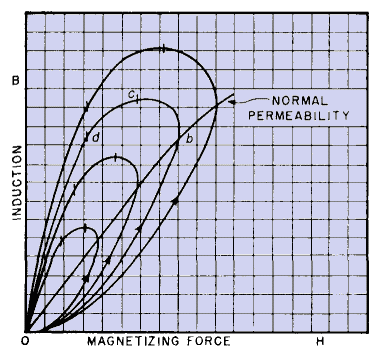| Electronic Transformers and Circuits is a free introductory textbook on transformers and related circuits. See the editorial for more information.... |

|

Home  Pulse and Video Transformers Pulse and Video Transformers  Core Material Core Material |
||||||||






|
||||||||
Core Material
In Higher-Frequency Transformers it was shown that core permeability decreases with frequency, especially at frequencies higher than audio. This decrease also occurs with short pulse widths. When a pulse is first applied to the transformer, there is initially very little penetration of flux into the core laminations because of eddy currents. Hence initially only a fraction of the total core is effective, and the apparent permeability is less than later in the pulse, or after the flux density becomes uniform throughout the laminations.
A typical B-H curve for pulse transformers is shown in Fig. 240. Flux density builds up in the core in the direction shown by the arrows.
For any number of pulses of varying amplitudes but of the same width, there are corresponding loops having respective amplitudes c. A curve drawn through point b of each loop is called the normal permeability curve, and this is ordinarily given as the permeability curve for the material. The permeability μ for a short pulse width is less than the 60-cycle or d-c permeability for the same material. Values of pulse permeability for 2-mil grain-oriented steel are given in Fig. 241.
The permeability values include the irreducible small gap which exists in type C cores; the cores on which the measurements were made had a ratio of gap to core length lg/lc ≈ 0.0003, but the data are not critically dependent on this ratio. The effect of penetration time is clear. Flux densities attained in pulse transformers may be low for small units where very little source power is available, or they may be high (several thousand gauss) in high power units. This is true whether the pulse width is a few microseconds or 1,000 microseconds. The nickel-iron alloys in general have lower saturation densities, but higher permeabilities below saturation than either grain-oriented or ordinary silicon steel. Depending on the flux density chosen, the increase of permeability with the use of a nickel-iron alloy may vary from zero to 300 per cent. This increase holds also for long-time pulses, during which permeability may approach the 60-cycle value. In order to overcome the net d-c pulse magnetization which is in the same direction throughout each pulse, an air gap may be inserted in the core to prevent it from returning only to the residual magnetismvalue Br at the end of each pulse, and thereby limiting its useful pulse flux density range ΔB to the difference between maximum flux density Bm and residual Br (see Fig. 242).
This gap increases the effective length of the magnetic path and reduces OCL from the value it has with symmetrical magnetization. The reduction is less with core materials of low permeability. To maintain the advantage of high permeability in nickel-iron alloys, the core is "reset." This is done byarranging the circuit so that, during the period of backswing, sufficient negative current flows through the windings to overcome coercive force Hc and drop the flux density to the negative value of residual magnetism. Then nearly twice the previous maximum flux density (ΔB' in Fig. 242) is available for the pulse. Where resetting is possible, it is advantageous to use nickel-iron alloys; where resetting is not practicable, grain-oriented silicon steel is preferable.
|
||||||||
Home  Pulse and Video Transformers Pulse and Video Transformers  Core Material Core Material |
||||||||
Last Update: 2011-01-24




